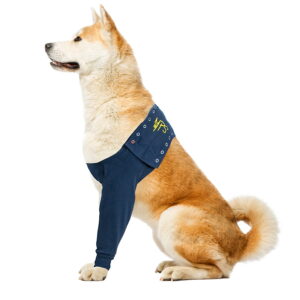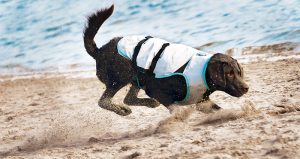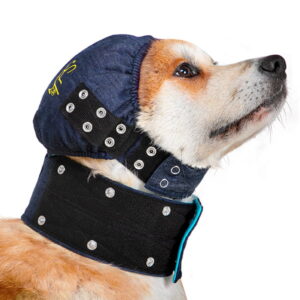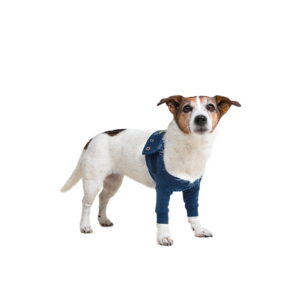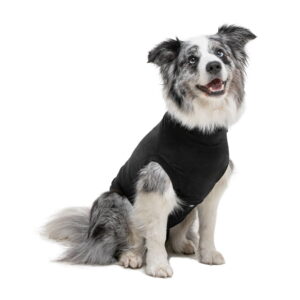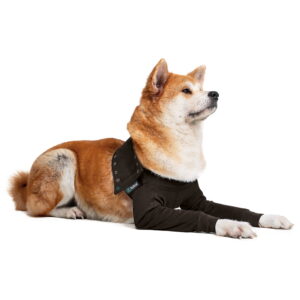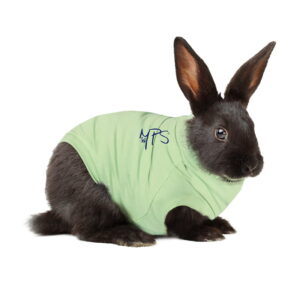Recovery Suits vs Elizabethan Collars: A Better Alternative to the Cone of Shame?
If your pet is coming home after surgery or dealing with a skin issue, you want something that protects the wound without adding stress. Recovery suits (also called medical recovery shirts) are a kinder, more practical alternative to the traditional Elizabethan collar or ‘cone of shame’. At TailMe, we carefully curate vet-recommended recovery wear for dogs, cats, and even rabbits, with fast South African delivery and easy returns on sizing.
Quick take:
- Recovery suits keep pets comfortable while preventing licking and scratching of the body and abdomen.
- Cones still have a place for certain injuries (especially face, paw, or tail-tip wounds) or for determined chewers.
- Most pets can eat, sleep, and toilet normally in a well-fitted recovery suit.
What is an Elizabethan collar (cone)?
A cone is a rigid funnel placed around the neck to stop a pet from reaching wounds with their mouth. Cones can work well for face and paw injuries, but many pets find them stressful and restrictive during daily activities like eating, sleeping, and navigating the home.
What is a medical recovery suit/shirt?
A recovery suit is a soft, breathable, stretchy garment that covers the body to protect stitches, hotspots, or skin conditions. Brands we stock (MPS Veterinary Range and Suitical) are designed with vets, include bathroom access options, and are machine-washable.
Recovery suit vs cone: pros and cons
Recovery suit (medical recovery shirt)
- Comfort: allows normal eating, sleeping, and cuddles; reduces stress for many pets.
- Protection: covers the torso, groin, and flanks; limits licking and scratching.
- Mobility: no blocked vision or bumped furniture.
- Hygiene: built-in flaps or poppers for toilet breaks; fabric shields from dirt.
- Limits: does not block access to paws, lower legs, tail tip, or face unless paired with sleeves/boots; determined chewers may still need backup.
Elizabethan collar (cone)
- Protection: blocks mouth access to most areas, including paws and face.
- Cost/simple: widely available and simple to fit.
- Limits: can hinder vision and movement; can interfere with eating and sleeping; may increase stress and lead to minor bumps or skin rubs.
Helpful context: Peer-reviewed veterinary literature has associated e-collars with increased stress and reduced activity in some pets. Clothing alternatives, used appropriately and as advised by your vet, can improve welfare during recovery.
Can my pet eat, sleep, and go to the bathroom in a recovery suit?
Eating and sleeping
- Most pets eat and sleep normally in a well-fitted suit. The fabric moves with the body and does not block vision or jaw movement.
- Tip: remove the suit for a few minutes if it is soiled after meals, then refit.
Bathroom access (dogs)
- Females: unfasten or roll back the rear flap and secure it using the built-in ties/snaps before going outside. Refasten after toileting.
- Males: open the rear panel further so the sheath is clear for urination. For bowel movements, roll and secure the flap higher so nothing obstructs.
- Keep the fabric clean and dry around the groin. If your dog squats low or has a fluffy backend, trim long fur and check for soiling after each walk.
Bathroom access (cats)
- Cats can use the litter box normally. For females, roll back and secure the rear flap. For males, ensure the penis area is unobstructed. Check the flap is refastened snugly after each box visit.
Hygiene tips
- Keep one spare suit to rotate while washing.
- If toileting is messy or your pet has diarrhoea, consider adding unscented baby wipes and a quick rinse of the flap area after each bathroom break.
Sizing and fit: how to measure your pet
Measure in a natural standing position: 1) Back length: from base of neck to base of tail. 2) Chest/girth: the widest part behind the front legs. 3) Neck circumference: for comfort around the collar area.
Fit guidance
- Prioritise chest/girth if between sizes. The suit should be snug like a T-shirt, not tight.
- Long-bodied breeds (e.g., Dachshund): you may size up on length; check that the belly panel still sits flush.
- Barrel-chested breeds (e.g., Staffie): choose the size that fits the chest; the fabric will stretch along the body.
- Cats: many cats fit dog sizes based on chest. Choose a close fit to prevent wriggling out.
- Free returns on sizing issues and fast exchanges across South Africa.
Need help? Use our size chart and message our team for breed-specific advice.
When a cone is still necessary
Use a cone (or a cone plus recovery wear) if:
- The wound is on the face, ear, or neck and your pet can reach it with a paw.
- The injury is on a paw, lower leg, or tail tip unless you add a recovery sleeve or boot.
- Your pet is an aggressive chewer or persistently works around clothing.
- Your vet specifically instructs you to use a cone due to drain placement or complex sutures.
Pairing ideas
- Suit + recovery sleeve for forelimb or hindlimb incisions.
- Suit + boot for paw pad injuries.
- Suit + cone for face wounds or very determined groomers.
Procedure-specific guidance
Spay/neuter (dogs and cats)
- Recommended: full-body recovery suit to cover the abdominal or pre-scrotal incision.
- Typical wear: 10–14 days or as directed by your vet.
- Benefit: reduces licking; most pets sleep and eat better than with a cone.
C-section and abdominal surgery
- Recommended: full-body suit with easy-open belly for checks and cleaning. Nursing mothers can temporarily open belly access to nurse under supervision.
- Typical wear: as per vet instruction; keep incision dry and inspect twice daily.
TPLO/CCL and orthopaedic knees
- Recommended: recovery sleeve for the operated leg to deter licking at the incision; consider a soft cone backup if needed.
- A full suit adds body coverage and keeps bedding clean.
Hot spots, dermatitis, and allergy flare-ups
- Recommended: suit to reduce self-trauma, plus targeted sleeves if the lesion is on a leg. Keep fabric clean and dry.
Tail/anal gland procedures
- Suit can protect the base of the tail and perineal area; some pets still need a cone to prevent tail chewing.
Paw injuries, post-dewclaw, or bandage worries
- Pair a recovery sleeve or boot with the suit to discourage chewing and keep dressings clean.
Rabbits and small pets
- We stock rabbit-specific recovery shirts designed for delicate skin and mobility.
Always follow your vet’s plan. Do not cover drains or heavily exudative wounds unless your vet says it is safe to do so.
Care, washing, and safety tips
- Washing: follow the garment label. Many veterinary-grade shirts (e.g., MPS) are washable at higher temperatures (up to 60°C) to help with hygiene.
- Drying: air-dry flat or tumble on low if permitted by the label. Avoid high heat that can damage elastic fibres.
- Frequency: wash daily if soiled, or every 1–2 days during active healing. Keep a spare suit to rotate.
- Skin checks: twice daily, check for dampness, chafing under the arms, and any discharge or odour.
- Activity: keep exercise gentle and controlled unless your vet approves more.
- Red flags: swelling, heat, redness, discharge, foul smell, or your pet becoming unusually quiet or agitated. Contact your vet promptly.
Best recovery suits by need (curated picks)
- MPS Veterinary Range Shirt DOG — Best for spay/neuter and abdominal surgery
- Suitical Recovery Suit DOG — Easiest bathroom access and daily wear
- Suitical Recovery Sleeve DOG — Best for leg surgeries, hotspots, or licking
- MPS Veterinary Range Boot — Paw protection after surgery or bandaging
- MPS Veterinary Range Shirt CAT — Cat-friendly fit; litter box compatible
- MPS Veterinary Range Shirt RABBIT — Gentle coverage for rabbits
All options are machine-washable, breathable, and vet-recommended. Free returns on sizing issues, secure checkout, and fast shipping anywhere in South Africa.
FAQs
Is a recovery suit better than a cone?
- For body and abdominal wounds, many pets do better in a recovery suit because it is comfortable and reduces stress. For face, paw, and tail-tip wounds, a cone (sometimes alongside a suit/sleeve) may still be the safest option. Follow your vet’s advice.
Can dogs and cats pee and poop while wearing a recovery suit?
- Yes. Open and secure the rear flap before toilet time, then refasten snugly. Check the area stays clean and dry. Cats can use the litter box normally with the flap secured out of the way.
How long should my pet wear a recovery suit after spay/neuter?
- Typically 10–14 days, or as your vet directs. Keep it on at night and whenever your pet is unsupervised.
Do recovery suits stop licking and chewing stitches?
- They physically block access to covered areas and reduce over-grooming. For uncovered areas (paws, face, tail tip) add a sleeve/boot or a cone as recommended by your vet.
How do I measure and choose the right size?
- Measure back length, chest/girth, and neck. Prioritise chest if between sizes and aim for a snug, not tight, fit. Use our size chart or message our team for breed-specific tips.
Can my pet sleep in a recovery suit?
- Yes. Most pets sleep more peacefully in a suit than in a cone. Always check for overheating in hot weather and keep the room cool. See our guide: Can My Pet Sleep in a Recovery Suit? Comfort and Safety Explained.

